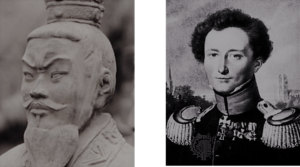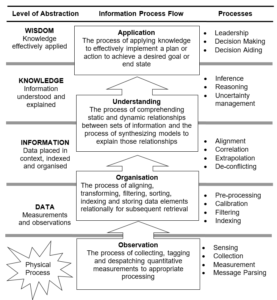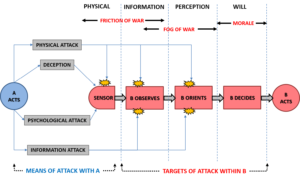INFORMATION OPERATIONS: ORIGINS AND FUNDAMENTALS - PART I
Sections
Introduction
The Importance of Information in Warfare
“Third Wave” Warfare
Generations of Warfare
Some Modern Warfighting Concepts
Cognitive Hierarchy
An Information Model of Warfare
The IW Battlespace
IW – A Paradigm Shift?
References
Introduction
Information Warfare (IW) is expected to play an increasingly dominant role in twenty first century conflict, wherein military superiority is a composite function of combat, electronic and information superiority. In this Information Age, we have for the first time the capability to intercept, analyse and disseminate information in real time, with the potential to wage war in the information dimension in powerful new ways.
IW as a concept is quite old. In World War-II, elements of IW appeared in the use of cryptography, radar and propaganda. Vietnam saw the first use of satellite communication and tactical computers as applied in psychological warfare. The Gulf War is called the first modern Information War [1]. The role of IW has been increasing proportional to the exceptional growth in technology over the past few decades.
The shift from mass and mobility to non-traditional methods of enhancing combat effectiveness is achieved by the convergence of a number of evolving technologies. In this series are developments in imaging, remote sensing, night sensors, precision guided munitions, stealth and above all digital communications and computer networks. Just as Industrial Age led to the concepts of mechanised warfare, emerging and enabling technologies are heralding the era of IW. There is a perceptible shift from application of brute force to brain force.
Changing information technologies are also having a profound effect on the nature of the battlespace. The traditional notions of time, space and force have changed forever: Time has been compressed; space has been distorted and expanded; and so our notions of force are also undergoing change [2].
In this Information Era, IW appears to have the potential of becoming the dominant rather than a supplementary form of warfare. Various armies are continuously evolving their concepts, doctrines and roadmaps for operationalising Information Operations (IO, a term often used synonymously with IW, and taken to mean “applied IW” for the purpose of this text). This two-part write-up attempts to introduce the concept of IW/ IO, with a view to discussing its applicability and importance in 21st Century warfare in subsequent posts.
In this first part, to begin the fact that the battle for information has been at the core of military operations throughout the ages is highlighted. Thereafter, the idea of three “waves” of warfare proposed by the futurists Alvin and Heidi Toffler are touched upon. The write-up then dwells on certain theoretical underpinnings of IW, such as a Cognitive Hierarchy, an Information Model of Warfare and the notion of an Information Battlespace.
The Importance of Information in Warfare
Throughout history, military leaders have recognized the key role of information as a contributor to victory on the battlefield. Commanders have always sought – and sometimes gained – a decisive information advantage over their adversaries. The writings of both Sun Tzu and Clausewitz reflect the key role of information in warfare. Sun Tzu, writing 2,500 years ago, emphasized the importance of knowledge in war.
“Know the enemy and know yourself; in a hundred battles you will never know peril. When you are ignorant of the enemy but know yourself, your chances of winning or losing are equal. If ignorant of both your enemy and yourself, you are certain in every battle to be in peril.”
– Sun Tzu in The Art of War

Sun Tzu (Left) and Carl von Clausewitz (Right)
“The general unreliability of all information presents a special problem: all action takes place, so to speak, in a kind of twilight, like fog. War is the realm of uncertainty; three quarters of the factors on which action in war is based are wrapped in a fog of greater or lesser uncertainty. The commander must work in a medium which his eyes cannot see, which his best deductive powers cannot always fathom; and which, because of constant changes, he can rarely be familiar.”
– Carl von Clausewitz’s in On War
As a result of this enduring characteristic of war, military organizations have, for centuries, been designed to accommodate the lack of available information, that is, how to deal with the fog of war. Fog is all about uncertainty. Uncertainty about where everyone is, what their capabilities are, and the nature of their intentions. Until recently a commander could not even have a timely and accurate picture of his own forces let alone be comfortable in his knowledge of where the enemy was and what they were up to. Friction is all about the glitches that occur in carrying out plans to synchronize forces or even to accomplish the most simple of tasks. Some of this friction can be attributed to fog, some to poor communications, and some to a lack of shared knowledge. To compound the problem, decision making in war carries with it an extremely high cost of error. Therefore, it is not surprising that military concepts of operations, organizations, doctrine and training have always been preoccupied with reducing the effects and risks associated with fog and friction.
These enduring characteristics of war have shaped our traditions, our military culture, and our thinking. Departure from these norms is difficult and requires a high degree of assurance that the new way is not only better, but also robust.
Recent advances in technology offer an opportunity to reduce fog and friction. However, despite all of the advances that have and will likely be made, significant residual fog and friction will persist. The nature of this residual uncertainty is, as yet, unclear and its implications are not fully understood. Nevertheless, in this Information Age, there is an historic opportunity to reconsider how best to deal with the fog and friction that will remain even with advancements in technology and the change in the ways of warfighting. Two warfighting paradigms which have emerged in this respect over the last few decades are Network Centric Warfare (NCW) and Information Warfare (IW).
“Third Wave” Warfare
Alvin and Heidi Toffler, as early as 1993, articulated the implications of transition from a “second wave” Industrial Age to a “third wave” Information Age – involving a great shift in the conduct of warfare (analogous to similar changes in business) in ten different areas [3], as under:-
- Factors of Destruction. The production and dissemination of information is critical to manoeuvring, supplying and precision targeting.
- Intangible Values. The central resource has shifted from tangible combat potential to intangible information.
- De-Massification. There is a shift from mass destruction to precision targeting.
- Worker Specialization. War is becoming increasingly specialised, requiring a commitment to specialised skills.
- Continuous Change. Continuous learning and innovation characterise the war-fighting forces of the Information Age.
- Scale of Operations. Military forces will become more customised and move toward smaller and more complex integrated force units.
- Organizations. Leveraging the power of information networks, field force organisation will transition from a hierarchical structure toward networks. Military units will gain flexibility and autonomy.
- Management. Integrated and inter-disciplinary units will replace hierarchical organizations.
- Infrastructure. Physical infrastructures of units will give way to infrastructures that are based upon utility of information.
- Acceleration of Processes. The process loops will become tighter as information is applied to deliver weapons with increasing speed. Operational concurrence, “just in time” delivery and near real-time control will characterise military processes.
Generations of Warfare
Wars and conflicts have been part of human history since existence of mankind. With social, political and technological changes in the world, the techniques and objectives of war have evolved from ancient times to modern era. Wars have evolved from unsophisticated warfare, from tribal/regional clashes to the world wars, from religious order to the state wars and from linear battles to manoeuvre warfare and beyond. The changing face of war was categorised as “generations of warfare” in 1989 by a team of US analysts, led by William S Lind [4] & [5]. As per this taxonomy, warfare has been classified into four generations, details of which may be found in an earlier post on The Changing Nature of Warfare – Part I. Although information is key in any form of warfare, IW finds particular resonance in Fourth Generation Warfare (4GW).
Some Modern Warfighting Concepts
Some other warfighting concepts which have been propounded over the last few decades, such as Asymmetric Warfare, Unrestricted Warfare and Hybrid Warfare, have been briefly discussed in an earlier post on The Changing Nature of Warfare – Part II. A more rigorous treatment of the subject (in subsequent posts) would show that IW forms a key element is almost all forms of modern conflict.
Cognitive Hierarchy
Information, the central resource of third wave warfare, can be viewed from three levels of abstraction forming a cognitive hierarchy (depicted in the figure below) [6], moving from Data (the least abstract, or most specific) to Knowledge (the most abstract, or conceptual form). The term “Information” is generically used to refer to all three levels. Finally, Wisdom is Knowledge effectively applied.

The Cognitive Hierarchy
An Information Model of Warfare
In order to illustrate the role of information in warfare, the following figure depicts a one-directional model of conflict, based on Colonel James Boyd’s Observe – Orient – Decide – Act (OODA) loop: An attacker A engages a defender B, who must determine how to react. Three major factors influence B’s decisions:-
- The capacity of B to act – A physical factor (command capability and force strength).
- The will of B to act – A human factor, most difficult for the attacker to directly influence.
- The perception of B – An information factor (accuracy, completeness, uncertainty and timeliness).

Model of the Information Processes in a Conflict
The model shows the flow of information from the attacker, across four domains to the decisions and actions of B. In an effort to coerce B’s decisions, four forms of attack are available to A (these directly correspond to offensive IW capabilities discussed subsequently in Chapter IV), as under-
- Physical Attacks. These are attacks using physical means (kinetic energy (KE) weapons, commando forces) on observation (sensors, communications) or orientation processes (command nodes).
- Information Attacks. These are electronic and semantic (over computer networks) attacks which may target the electronic and computer based observation and orientation processes.
- Deception. This form of attack may use means in different domains to distort B’s perception, thus reducing his effectiveness.
- Psychological Attacks. These are attacks meant to influence the perception and/ or the will of B.
The IW Battlespace
The above model also illustrates that the IW battlespace spans three different domains, as under:-
- The Physical Domain. The physical domain is the traditional domain of warfare where force is moved through time and space. It spans into the land, sea, air, and space dimension where military forces execute the range of military operations and where the physical platforms and communications networks that connect them reside. Comparatively, the elements of this domain are the easiest to measure, and consequently, combat power has traditionally been measured in the physical domain.
- The Information Domain. The information domain is the domain where information is created, manipulated, and shared. It is the domain that facilitates the communication of information among war fighters. It is where command and control (C2) of military forces is communicated and the commander’s intent is conveyed. Consequently, it is increasingly the information domain that must be protected and defended to enable a force to generate combat power in the face of offensive actions by an adversary. Finally, in the all-important battle for information superiority, the information domain is ground zero.
- Cognitive Domain. The cognitive domain is in the mind of the war fighter. Battles, campaigns, and wars are won in this domain. The intangibles of leadership, morale, unit cohesion, level of training and experience, and situational awareness are elements of this domain. This is the domain where a commander’s intent, doctrine, tactics, techniques, and procedures reside.
The distinguishing characteristic of IW is that the target is always information residing (or flowing) in either the information systems or the human mind.
IW – A Paradigm Shift?
Many of the principles enunciated by Sun Tzu rely on acquisition, processing and dissemination of information. The principles have not changed, but the means of acquisition, processing and dissemination have. The increasing use of electronic means for managing large volumes of information and the increasing value of that information have together made information itself a lucrative target and a valuable weapon of warfare.
One accepted classification of earlier paradigm shifts in warfare is as follows: First and second generations of warfare were “line and column” and “trench warfare” respectively, with third generation warfare being “manoeuvre warfare” [4]. Does IW qualify as fourth generation warfare? The following may be stated in this respect:-
- All warfare is aimed at making the adversary capitulate to the attacker’s wishes, ideally by “breaking his resistance without fighting”. In general, to achieve this end, operations in all the three realms of the battlespace are carried out.
- The first three generations of warfare were predominantly fought in the physical realm, with operations in the information and perceptual realms (especially the former) playing lesser roles.
- In the case of IW, the converse is true. While IW operations may be mounted in the physical realm also, IW weapons and targets are primarily concentrated in the information and perceptual realms.
- Another new aspect of IW is the expansion of the battlespace beyond the traditional military realm. Information targets can include the entire civil and commercial infrastructure of a nation.
- In today’s crisis/ conflict scenarios, while use of pure IW weapons may yield some results, achieving a military victory by such means may not be feasible. If this be so, should IW denote a paradigm shift in warfare?
- In this context there are two views: Some visualise physical force as soon becoming secondary to information/ perceptual force. Others see attacks at the information/ perceptual levels continuing to remain as adjuncts to conventional warfare. In the view of the author, if the former view turns out to be true, IW would indeed qualify to be classified as a generational change in warfare.
- While the jury is still out, conflicts in the information and perceptual realms are clearly seen to be intensifying on the world stage.
The above view may be contrasted with the concept of fourth generation war given by William S Lind in the context of asymmetric warfare [7].
This discussion is carried forward in Part II of this write-up, wherein some well-accepted IW taxonomies are given out, followed by a brief overview of the notion of Information Superiority. Finally, some comments are made on the status of IW in the Indian context.
References
(1) Alan D Campen, ed., The First Information War, Bookmart Publishers, New Delhi.
(2) Michael L Brown, The Revolution in Military Affairs: The Information Dimension in Alan D Campen, Douglas H Dearth and R Thomas Goodden, ed., Cyberwar, Bookmart Publishers, New Delhi, 2000, pp. 33.
(3) Alvin and Heidi Toffler, War and Anti-War, Warner Books, London, 1993, pp. 86-103.
(4) William S Lind et al, The Changing Face of War: Into the Fourth Generation, Marine Corps Gazette, Oct 1989, pp. 22-26.
(5) Imperial and Royal Austro-Hungarian Marine Corps, Fourth Generation War, Fleet Marine Force Manual 1-A, 12 Aug 2008, pp. 29-30.
(6) Edward Waltz, Information Warfare: Principles and Operations, Artech House, Inc., Norwood, 1998, pp. 51.
(7) William S Lind, Fourth Generation War in Military Reform, Greenwood Publishing Group, Inc., Westport, 2007, pp. 194-219.


0 Comments